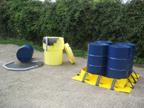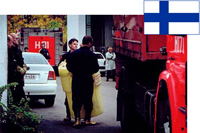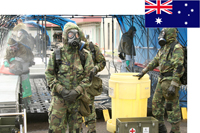When selecting outdoor chemical storage buildings your choice will depend on the materials to be stored, how the building will be used, the volume of the materials being stored and the location of the building and design requirements.
If the materials to be stored are either flammable or combustible, you will need a building that meets the NFPA Code 30, Uniform Fire Code (UFC) Articles 79 and 80, or an equivalent local code. Check with the authority having jurisdiction (AHJ) to determine which code is locally enforced.
The class of the flammable-combustible material (refer to NFPA Code 30) can also dictate what type of building construction is required. Class I, II, or III flammable and combustible liquids will require either a non-combustible building or a fire-rated building. Non-combustible buildings are constructed of non-combustible material (such as steel), whereas a fire-rated building is constructed of non-combustible materials and includes fire resistant insulation in the walls. Fire-rated buildings are further divided into categories based on the fire resistance of the walls, roof and openings (doors and vents).
With the 2012 revision to the Occupational Safety and Health Administration’s (OSHA’s) Hazard Communication standard and the adoption of portions of the Globally Harmonized System of Classification and Labeling of Chemicals, flammable liquids are now either Category 1, 2, 3, or 4 flammable liquids. The NFPA fire codes still identify liquids as flammable IA, IB, IC or combustible II, IIIA and IIIB liquids. Information regarding the flammability of the chemical you are storing is located in Section 9 of the Safety Data Sheet (SDS).
OSHA’s Flammable Liquid Categories (29 Code of Federal Regulations 1910.106)
| Category | Flashpoint | Boiling Point |
|---|---|---|
| Flammable 1 | < 73.4 °F | ≤ 95 °F |
| Flammable 2 | < 73.4 °F | > 95 °F |
| Flammable 3 | > 73.4 °F - ≤ 140 °F | |
| Flammable 4 | > 140 °F - < 199.4 °F |
NFPA Flammable and Combustible Liquid Classifications
| Term | Class | Flash Point | Boiling Point |
|---|---|---|---|
| Flammable | IA | < 73 °F | < 100 °F |
| Flammable | IB | < 73 °F | ≥ 100 °F |
| Flammable | IC | 73 °F - < 100 °F | |
| Combustible | II | 100 °F - < 140 °F | |
| Combustible | IIIA | 140 °F - < 200 °F | |
| Combustible | IIIB | ≥ 200 °F |
When storing non-flammable liquids, a non-combustible building may be sufficient, but you should check with the AHJ for specific requirements.
The design of the building will also be affected by whether or not you will be dispensing from containers stored in the building. Explosion relief panels are required for buildings that store and dispense Class IA liquids and that dispense Class IB liquids. Otherwise, an explosion relief panel is not required.
The interior of the building should accommodate the number of containers required in a single layer and have adequate sump capacity to comply with the Environmental Protection Agency (EPA) Secondary Containment Requirements (40 CFR 264). To meet this regulation, the sump containment should be large enough to hold 100% of the volume of the largest container stored in the building or 10% of the total volume of all containers stored in the building, whichever is larger.
The type of building you select will also have a bearing on the chosen location. Factory Mutual (FM), an insurance and testing agency, no longer specifies minimum distances between the storage building and any other main (occupied) building on the site and the property line of the facility. FM leaves the setback distances up to the AHJ.
Construction of outdoor chemical storage buildings must comply with a number of regulations including EPA 40 CFR 264, OSHA 29 CFR 1910.106, NFPA Codes 30 and 70, and UFC Article 79 and 80. In addition to the construction requirements, certain approvals may also be required for these buildings. These approvals include UL (Underwriters Laboratories) Classification and FM Approval. Additionally, certain states require that a Professional Engineer apply a Seal of Approval to the building, indicating that it meets all state regulations. Contact the AHJ for more details on the State Seal Program and to verify if your state requires an approval seal.
A variety of options are available for outdoor chemical storage buildings. The options allow you to meet both your regulatory requirements and your custom design needs. Available options include electrical service, heating and cooling systems, fire suppression systems, exterior and interior lighting, shelving, ramps, insulation, emergency eyewash and shower and explosion-resistant features. .
If you have further questions regarding outdoor chemical storage buildings or if you would like help selecting and designing a building to meet your needs, contact your local Grainger Account Manager.
Sources
29 CFR 1910.106 Flammable Liquids
40 CFR 264 Standards for Owners and Operators of Hazardous Waste Treatment, Storage and Disposal Facilities
National Fire Protection Association Code 30 Flammables and Combustible Liquid Codes 2015 Edition
www.nfpa.org
Factory Mutual
Norwood, MA
www.fmglobal.com
(Rev. 7/2015)
Find even more information you can use to help make informed decisions about the regulatory issues you face in your workplace every day. View all Quick Tips Technical Resources at www.EHSCity.com/law.
Think EHS Think EHSCity.®
EHSCityhas the products, services and resources to help keep employees safe and healthy while operating safer facilities. You’ll also find a network of safety resources that help you stay in compliance and protect employees from hazardous situations. Count on EHSCity for lockout tagout, fall protection equipment, confined space products, safety signs, personal protective equipment (PPE), emergency response and so much more!
Please Note:
The content in this newsletter is intended for general information purposes only. This publication is not a substitute for review of the applicable government regulations and standards, and should not be construed as legal advice or opinion. Readers with specific compliance questions should refer to the cited regulation or consult with an attorney.



